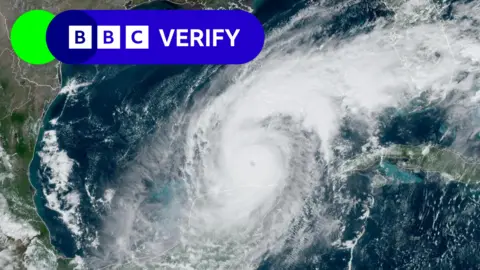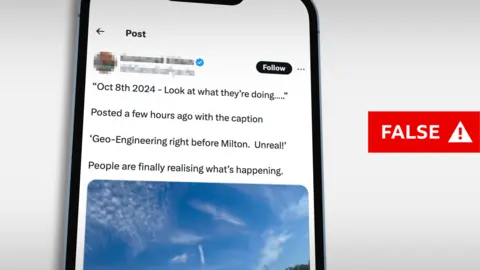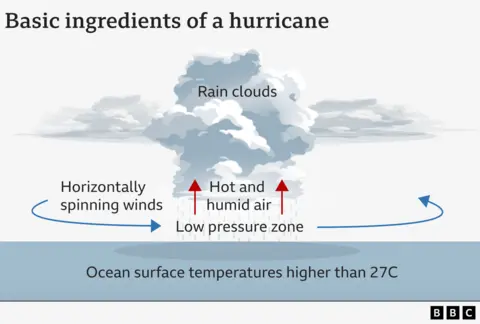 Reuters/NOAA
Reuters/NOAAFalse claims suggesting that Hurricane Milton was “engineered” and that the weather in Florida is being “manipulated” have been spreading on social media.
There is no technology that allows humans to create and control hurricanes.
But on platforms like X and TikTok, posts alleging – without evidence – that the US government is secretly controlling the weather have been viewed millions of times.
Many were published by accounts known for spreading conspiracy theories, as well as misinformation about Covid-19 or vaccines.
On Wednesday, US President Joe Biden described the claims as “beyond ridiculous”, adding “it’s so stupid, it’s got to stop”.
He was responding to Republican congresswoman Marjorie Taylor Greene, who in recent days suggested on her social media accounts that the US government “can control the weather”.
Posts seen by BBC Verify mainly suggest Hurricane Milton, one of the strongest storms in recent US history, was purposefully created by shadowy forces at the heart of US politics.
But the accounts making that claim proposed several different explanations for how that was supposedly done.
Some users alleged weather manipulation techniques like cloud seeding are to blame.
Cloud seeding involves manipulating existing clouds to try to produce more rain, for example in countries with a dry climate.
But the south-east of the US had already been hit by huge amounts of rainfall from Hurricane Helene, which triggered deadly flooding in several states just two weeks ago.
“When we cloud seed, it is because we do not have enough aerosols or water vapor within the atmosphere to see condensation occur, so we try and force it through cloud seeding,” says Jill Trepanier, an expert in extreme weather phenomena from Louisiana State University.
“Over the western Gulf of Mexico and the Bay of Campeche, that is not a problem. The Earth will make a hurricane all on its own.”
Other users blamed “geoengineering” instead – a wide array of methods to manipulate the environment with a view to reducing the effects of climate change.

But there are no tools that would allow humans to create or control storms like this one.
“There is no possibility using current knowledge and technology to use geoengineering to modify hurricanes,” says Suzana Camargo from the Lamont-Doherty Earth Observatory at Columbia University.
Hurricanes are natural weather systems.
Typically they begin as what is known as a tropical wave – a low pressure area where thunderstorms and clouds develop.
As strong winds push this system away from Africa and towards the Americas, warm, moist air rises from the tropical Atlantic Ocean, and the system of clouds and winds begins to spin.

With sufficient energy from the warm ocean waters, combined with favourable circulation patterns in the atmosphere, it may be able to strengthen into a full hurricane.
Social media posts seen by BBC Verify wrongly suggest hurricanes like this one are being created for sinister reasons, including to attempt to sway next month’s presidential election.
Those assertions are false, but there is a link to human activity because of the way climate change is making these storms generally more intense.
Climate change – caused by emissions of planet-warming gases such as carbon dioxide from human activities – is not thought to be increasing the number of tropical storms worldwide.
But rising temperatures do make the strongest hurricanes more likely.
Warmer seas mean that these storms can pick up more energy, potentially leading to higher wind speeds.
Hurricane Milton strengthened particularly quickly as it moved over the Gulf of Mexico, where sea surface temperatures were around 1-2C warmer than average.
Peak sustained wind speeds increased from 90mph (150km/h) to 175mph (280km/h) in just 12 hours on 7 October, according to National Hurricane Center data.
For some social media users, this sudden change was perceived as “evidence” to back their suggestions this was not a “natural” storm, but instead one manufactured by humans.
But this trend fits with expectations of hurricanes generally intensifying more quickly in a warming world.
“As we warm the planet, we anticipate a lot of potential impacts to hurricanes that can make them more damaging – including the ability to strengthen more quickly over unnaturally warm ocean waters,” explains Andra Garner, an assistant professor at Rowan University in New Jersey.
Hurricane Helene – which hit Florida around two weeks ago – also intensified rapidly over the Gulf of Mexico.
A new study released on Wednesday found that the exceptionally high sea surface temperatures over its track were made hundreds of times more likely by human-caused warming.
“[Helene] was significantly more destructive because of climate change,” explains Ben Clarke of the World Weather Attribution group, which led the study.
Beyond typically stronger winds, climate change is also affecting other hurricane hazards.
A warmer atmosphere can hold more moisture – up to about 7% for every 1C of temperature rise. This means that rainfall can be more intense.
And global sea-levels have been rising in recent decades, largely thanks to global warming. This makes it more likely that a given storm surge – short-term increases to sea-levels from storms – will lead to coastal flooding.
In Florida, average sea-levels have risen by more than 18cm (7in) since 1970, according to US government data.
For some of the users spreading conspiracy theories around Hurricane Milton, this too amounts to “scaremongering”. But the evidence suggests otherwise.



